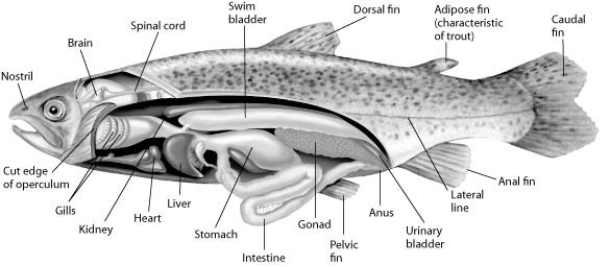Multiple Choice
 Fishes that have swim bladders can regulate their density and, thus, their buoyancy. There are two types of swim bladder: physostomous and physoclistous. The ancestral version is the physostomous version, in which the swim bladder is connected to the oesophagus via a short tube (see the figure) . The fish fills this version by swimming to the surface, taking gulps of air, and directing them into the swim bladder. Air is removed from this version by "belching". The physoclistous version is more derived and has lost its connection to the oesophagus. Instead, gas enters and leaves the swim bladder via special circulatory mechanisms within the wall of the swim bladder.
Fishes that have swim bladders can regulate their density and, thus, their buoyancy. There are two types of swim bladder: physostomous and physoclistous. The ancestral version is the physostomous version, in which the swim bladder is connected to the oesophagus via a short tube (see the figure) . The fish fills this version by swimming to the surface, taking gulps of air, and directing them into the swim bladder. Air is removed from this version by "belching". The physoclistous version is more derived and has lost its connection to the oesophagus. Instead, gas enters and leaves the swim bladder via special circulatory mechanisms within the wall of the swim bladder.
-If a ray-finned fish is to both hover (remain stationary) in the water column and ventilate its gills effectively, then what other structure besides its swim bladder will it use?
A) its pectoral fins
B) its lateral line system
C) its caudal (tail) fin
D) its operculum
Correct Answer:

Verified
Correct Answer:
Verified
Q4: A team of researchers has developed a
Q7: Why do adult urochordates (tunicates) lack notochords,
Q8: Which of these might have been observed
Q9: Primate evolution and behaviour, such as hunting
Q18: During chordate evolution, what is the sequence
Q45: Unlike eutherians, both monotremes and marsupials _.<br>A)
Q48: Marsupials survived in Australia (as opposed to
Q61: Use the following information to answer the
Q64: Ancient fossils that seem to be an
Q76: Which of the following is the most